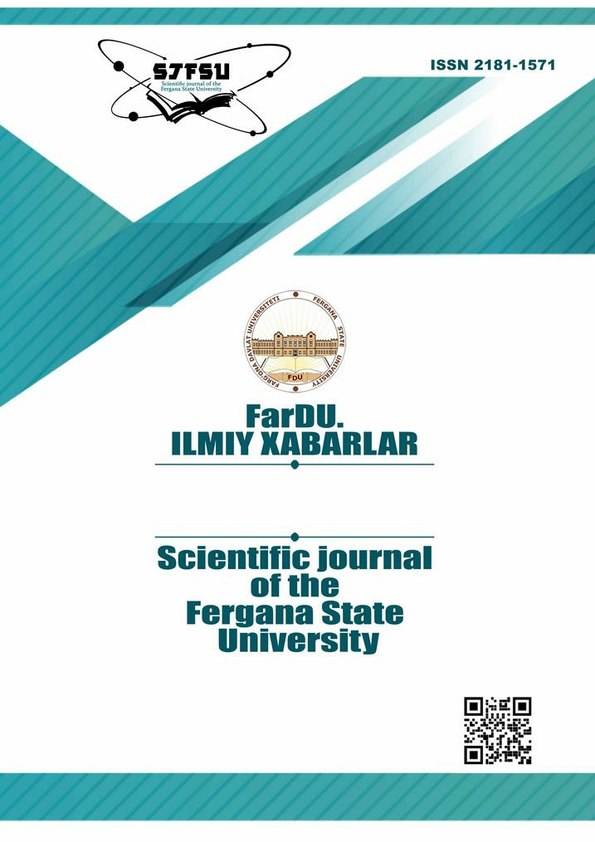AN IMPROVED METHOD FOR THE ISOLATION OF ARTEMISININ FROM ANNUAL WORMWOOD (ARTEMISIA ANNUA L.) GROWING IN UZBEKISTAN
Main Article Content
Abstract
The chemical composition of representatives of the plant Artemisia annua L. in different geographical regions, in particular the amount of artemisinin, was studied. However, the chemical composition of its representatives growing in Uzbekistan has not been studied. The aim of this study was to isolate and quantify artemisinin from the plant Artemisia annua L. in Uzbekistan, especially in the Ferghana Valley.The extraction of artemisinin from the plant Artemisia annua L. in organic solvents, thin layer and column chromatography, IR, and mass spectrometry were used to determine the physicochemical parameters, chemical composition, and structure of the isolated substance.Isolation of artemisinin from the plant Artemisia annua L., growing in the Ferghana Valley, was achieved by 1.2-1.5% by replacing organic solvents. The extraction process with petroleum ether was carried out at different times. It was found that the yield did not change significantly when the extraction time exceeded 2 days. When analyzing the IR and mass spectra of the obtained substance, it was noticed that the data corresponds to the structure of artemisinin.For the first time, the biologically active substance artemisinin was isolated from the plant Artemisia annua L. growing in the Ferghana Valley in Uzbekistan. Extraction and purification methods have been improved, and the overall yield has been increased to 1.5%.
Article Details

This work is licensed under a Creative Commons Attribution-NonCommercial-NoDerivatives 4.0 International License.
References
Xu, J., and Zhang, Y. (2020). Traditional Chinese medicine treatment of COVID-19. Complement Ther. Clin. Pract. 39, 101165..
Асқаров И.Р. Табобат қомуси. Т.: "Мумтозсўз". - 2019. - Б. 1142. (Askarov I.R. Folk medical encyclopedia. Т.: "Mumtoz suz", 2019, 1142)
Асқаров И.Р. Сирли табобат. – Т.: Фан ва технологиялар нашриёт-матбаа уйи. 2021. – Б. 1084. (Askarov I.R. Mysterious folk medicine. T.: Fan va texnologiyalar nashriyot-matbaa uyi, 2021, 1084)
Li, G., et al.. “Chapter 6: artemisinin and derivatives: clinical studies,” in Artemisinin-based and other Antimalarials: detailed account of studies by Chinese scientists who discovered and developed them. Cambridge, MA: Academic Press, 2018., 353–413.
Duc, D. D., et al. The pharmacokinetics of a single dose of artemisinin in healthy Vietnamese subjects. Am. J. Trop. Med. Hyg. 1994, 51 (6), 785–790.
WHO (2020). Guidelines for the treatment of malaria, 2nd edn. Geneva: World Health Organization Available at: http://apps.who.int/medicinedocs/en/m/abstract/Js19105en/.
Efferth, T., et al. The antiviral activities of artemisinin and artesunate. Clin. Infect Dis. 2008, 47 (6), 804–811.
Sehailia, M., and Chemat, S. (2020). In-silico studies of antimalarial-agent artemisinin and derivatives portray more potent binding to Lys353 and Lys31-binding hotspots of SARS-CoV-2 spike protein than hydroxychloroquine: potential repurposing, «of artenimol for COVID-19. ChemRxiv.».
Li, G., Yuan, M., Li, H., Deng, C., Wang, Q., Tang, Y., et al. (2021). Safety and efficacy of artemisinin-piperaquine for treatment of COVID-19: an open-label, non-randomised and controlled trial. Int. J. Antimicrob. Agents 57, 106216..
Health Care (2020). MGC Pharmaceutical’s (ASX:MXC) ArtemiC combats COVID-19. https://themarketherald.com.au/mgc-pharmaceuticals-asxmgc-artemic-combats-covid-19-2020-12-15/.
Lin, Y., Wu, F., Xie, Z., Song, X., Zhu, Q., Wei, J., et al. (2020). [Clinical study of artesunate in the treatment of coronavirus disease 2019], Zhonghua Wei Zhong Bing Ji Jiu Yi Xue 32 (4), 417–420..
Uckun, F. M. Reducing the fatality rate of COVID-19 by applying clinical insights from immuno-oncology and lung transplantation. Front. Pharmacol. 2020 b, 11, 796.
Коновалов Д.А., Хамилонов А.А. Биологически активные соединения полыни однолетней. Эфирноемасло. ФармацияифармакологияТ. 4 № 4, 2016, 4-33. (Konovalov D.A., Khamilonov A.A. Biologically active compounds of wormwood annual. Essential oil. Pharmacy and pharmacology T.4, Vol 4, 2016, 4-33)
Woodrow CJ, Haynes RK, Krishna S. Artemisinins. Postgrad Med J. 2005;81(952):71-78.
Asqarov I.R., Abdulloyev O.Sh., Fozilova G.E. Bir yillik shuvoqning kimyoviy tarkibi va shifobaxsh xususiyatlari. Материалы международной научно-практической онлайн- конференции с участием международных партнерских вузов от 6-7 мая 2021 года по теме Народная медицина: прошлое и будущее. Фергана 2021. С. 27-28. (15. Askarov I.R., Abdulloyev O.Sh., Fozilova G.E. Chemical composition and medicinal properties of annual wormwood. Materials of the international scientific and practical online conference with the participation of international partner universities from May 6-7, 2021 on the topic Traditional medicine: past and future. Fergana 2021. P. 27-28)
Klayman et al. Isolation of artemisinin (Qinghaosu) from artemisia annua growing in the United States. Journal of Natural Products. Vol. 47. No. 4. pp. 715-717.
Huimin Yu., et al. Preparation and Characterization of Micronized Artemisinin via a Rapid Expansion of Supercritical Solutions (RESS) Method. Int. J. Mol. Sci. 2012, 13, 5060-5073.

